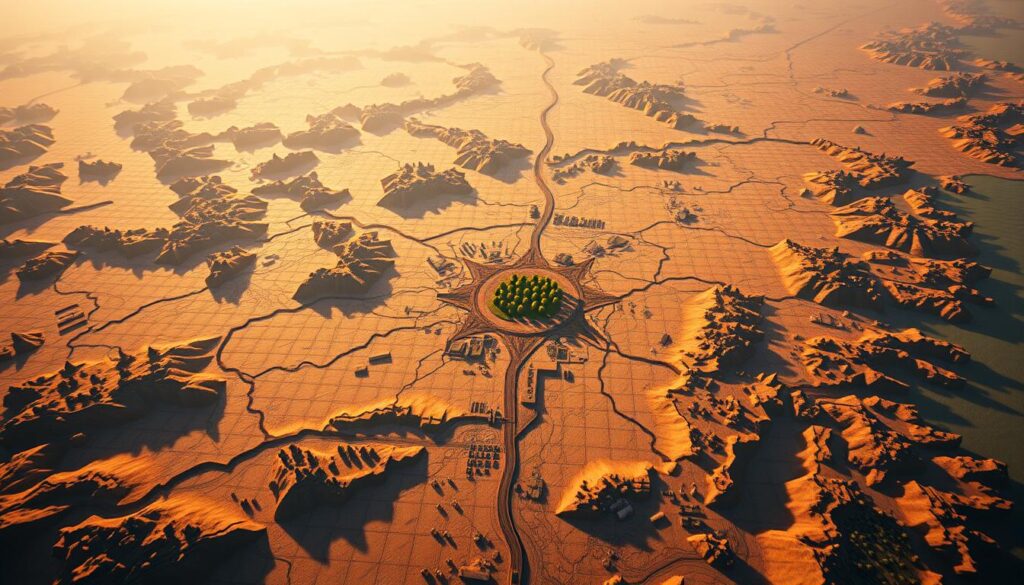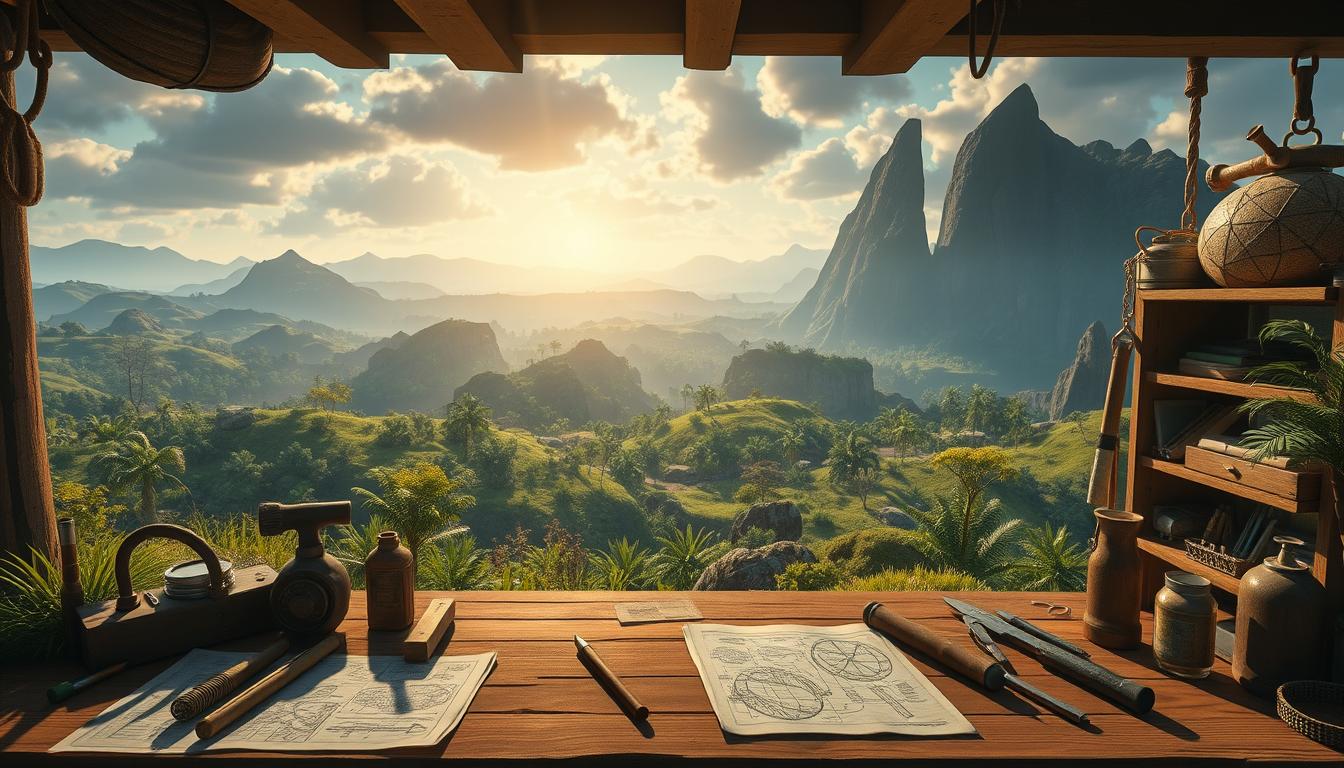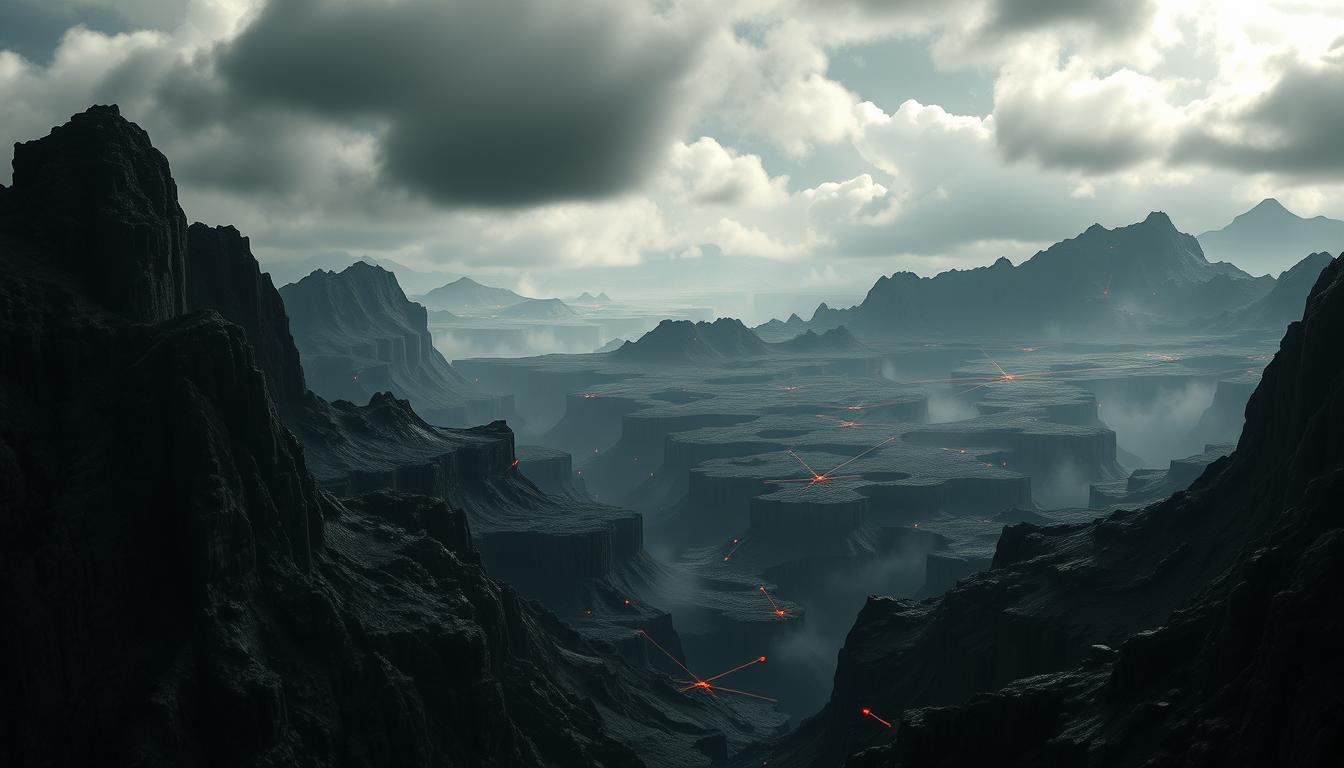Ever felt like some mobile RPGs are just too hard or too easy? This feeling often comes from a lack of Region-Based Difficulty Scaling. In procedural RPG maps, the right difficulty level is key to keeping players hooked. This article will show you how to make your game more engaging by adjusting the difficulty.
By using smart difficulty mechanics, you can make your game more fun and challenging. This is especially important for mobile games, where players face different obstacles. Let’s dive into how you can use difficulty scaling to create a better gaming experience.
Introduction to Difficulty Scaling in RPGs
Difficulty scaling is key to keeping players engaged in RPGs. It makes sure challenges grow with the player’s skills. This way, both new and experienced players can enjoy the game.
Game balance is all about finding the right level of challenge. It keeps the game exciting without being too hard or too easy. By adjusting the game as the player gets better, developers keep the game interesting.

The Importance of Region-Based Mechanics
Region-based mechanics are key to keeping players engaged in mobile RPGs. They make the game more immersive by offering different levels of challenge in each area. This approach sparks curiosity and encourages players to explore.
These mechanics help create a captivating atmosphere in the game. They tie challenges to specific areas, making the game world feel more real. As players move through different regions, they feel a sense of accomplishment and progress.
This approach boosts player satisfaction and keeps them playing longer. Players enjoy the variety of experiences in each region. It makes the game more rewarding and builds a deeper story.

Understanding Procedural Generation Techniques
Procedural generation is key in Game Map Design. It lets developers create vast, varied landscapes automatically. This method uses algorithms to make complex environments, cutting down on manual design work.
Methods like noise functions, fractal algorithms, and Voronoi diagrams are used. Noise functions, like Perlin noise, help make terrain look natural. They create mountains, hills, and valleys. Fractal algorithms add detailed, recursive patterns to landscapes. Voronoi diagrams divide space into unique areas, perfect for game maps.
These techniques make each player’s experience unique and engaging. They ensure every game is different, encouraging exploration. Players face new challenges and strategies in changing environments.
| Technique | Description | Benefits |
|---|---|---|
| Noise Functions | Creates natural terrain variations using mathematical algorithms. | Produces lifelike landscapes with minimal manual input. |
| Fractal Algorithms | Generates complex shapes and details through recursive patterns. | Enhances visual richness and variation in environments. |
| Voronoi Diagrams | Partitions space to create distinct regions or biomes. | Facilitates diverse gameplay experiences across different areas. |
By using these techniques, developers can make immersive RPG maps. They create innovative gaming experiences that draw players in.
Region-Based Difficulty Scaling in Procedural RPG Maps
Region-based difficulty scaling changes game challenges based on specific areas in a procedural RPG map. It makes gameplay better by matching experiences to player skills and likes. Knowing about difficulty scaling is key for developers to make games more engaging with varied challenges and settings.
What is Region-Based Difficulty Scaling?
Region-based difficulty scaling changes enemy strength, resources, and hazards based on the game area. It lets players face harder foes and bigger risks in certain zones. By using different levels of procedural RPG difficulty, developers make the world more exciting to explore.
Benefits of Implementing Difficulty Scaling
Using a region-based difficulty scaling system has many benefits. Players feel more immersed and excited as they find new areas with challenges that match their skills. Some main advantages of difficulty scaling are:
- Improved player retention: Players are more likely to keep playing a game that adjusts to their skill level.
- More meaningful exploration: Finding different regions with unique challenges makes players want to explore more.
- Rich gameplay experience: A well-scaled environment offers a good balance of challenge and reward, making the game more enjoyable.
Choosing the Right Difficulty Metrics
Choosing the right Difficulty Metrics is key to making an RPG fun and balanced. These metrics help us see how hard the game is and how happy players are. By looking at enemy fights, environmental hurdles, and quest complexity, developers can make games that meet player hopes.
Knowing what players can do is vital. By testing and listening to feedback, designers can make the game just right. The metrics should cover many aspects, so every player can have fun without getting stuck on hard parts.
Getting the game balance right is all about mixing these metrics well. Developers need to watch how the game gets harder as players get better. They aim to keep the game tough but fair. This makes the game more enjoyable and builds a strong bond between players and the game.
Creating Biomes and Regions for Your Maps
RPG Biomes are key in making a game world feel real. They offer players different challenges and rewards. This makes the game world more interesting and engaging.
Types of Biomes: Unique Challenges and Rewards
There are many types of RPG Biomes, each with its own experience. For example:
- Forests: They are full of plants and animals, but also have hidden treasures.
- Deserts: They are tough, but adventurers can find rare items.
- Mountains: They are hard to climb, but offer great rewards for those who try.
These environments make the game more exciting. They draw players into the story and offer fun challenges.
How Biomes Impact Player Experience
Biomes shape a player’s journey by setting the scene for quests and battles. They create a world that players want to explore. Players must use their skills to overcome the challenges of each biome.
This makes the game more enjoyable. It keeps the gameplay exciting and rewarding.
Designing a Region-Based System for Player Progression
Creating a region-based system for player progression needs careful thought. It’s important to balance story and gameplay mechanics. Developers should make sure the challenges and rewards in each region match the player’s growth. This way, players feel a sense of accomplishment as they move through different areas.
Building a system that players love involves several key elements:
- Balancing Difficulty: Each region should have its own level of challenge. This keeps players interested and eager to explore more.
- Variable Rewards: Give players rewards that fit their journey. This encourages them to keep exploring and supports the RPG design.
- Story Integration: Add story elements to each region. This makes the game more engaging and gives player progression a sense of purpose.
To make players happy, developers should aim to create a rewarding progression system. This not only improves gameplay but also strengthens the bond between players and the game world.
Implementing Enemy Scaling Based on Location
Enemy Scaling based on player location makes games more exciting. It offers challenges that change with the game world. This way, players get to explore and face enemies that fit each area.
By using Location-based Difficulty, games stay fun and challenging. It shows how well the player is doing in different places.
Best Practices for Enemy AI Adjustments
Effective Enemy Scaling is key in different game settings. Here are some tips for adjusting AI:
- Behavior Modulation: Change enemy tactics based on the area’s challenges. Enemies in tough terrains might use sneak attacks. Those in open areas might team up.
- Strength Variation: Change enemies’ health, damage, and skills based on the player’s level. Tougher areas have stronger enemies.
- Tactical Diversity: Create different enemy types that need unique strategies. This makes gameplay more dynamic and interesting.
- Environmental Interaction: Make AI use the environment. Enemies should act differently based on the area’s layout and obstacles.
Using Data to Inform Scaling Decisions
Data analysis is key in making smart scaling decisions for RPGs. It helps developers improve gameplay by tracking how players do and behave. Knowing how players tackle different areas and challenges helps make the game more fun and challenging for everyone.
Developers can see where games might be too hard or too easy by looking at player data. For example, if players finish certain parts of the game too quickly, it’s time to make it harder. This way, the game stays exciting and challenging.
Using player feedback in real-time helps spot trends that might not show up in early tests. This method makes sure each player gets a game that fits their skills and style. It makes the game feel more personal and fun.
Improving maps and challenges based on data makes players happier and keeps them playing longer. Players enjoy facing challenges that are just right for them, making the game more rewarding and fun.
Iterating on the Difficulty Curve
Creating a balanced difficulty curve in RPGs is a never-ending task. Game testing is key to finding out where players might find challenges or breeze through. By listening to player feedback, developers can spot areas that need tweaking. This ensures the game is both tough and fun.
Testing and Feedback Loops for Game Balance
The game development process needs constant refinement. Feedback loops help developers understand how players interact with the game. By testing at different stages, they can adjust the difficulty curve based on real feedback. This helps to pinpoint what might make players less engaged or unhappy.
To manage the iteration process well, consider these strategies:
- Hold focus groups to watch players play and get their thoughts on the game’s difficulty.
- Use surveys after gameplay to see how players feel about the challenges they faced.
- Use analytics tools to track how players do, finding out where they succeed or struggle.
When players share their thoughts, developers can make changes to improve the game. Finding the perfect difficulty level is more than just numbers. It’s about making a game that players want to keep playing.
Player Communication of Difficulty Changes
It’s key to keep players in the loop about changes in game difficulty. When developers share what’s coming, players can adjust their plans. This makes the game more enjoyable and lets players feel they’re in charge.
Effective ways to share include:
- In-game notifications that tell players about upcoming changes.
- Patch notes that explain what’s new and why it’s important.
- Community forums where players can talk and share their thoughts on the game.
Having open talks with players makes the game better. It brings developers and players closer together. By focusing on clear communication, developers can make the game more fun and fair for everyone.
Leveraging Community Feedback for Improvements
Understanding what players think is key to making RPGs better. By talking to players and listening to their ideas, developers can make maps and levels more fun. Feedback from the community gives insights that internal tests might miss.
Engaging with Players for Optimal Map Design
There are many ways to talk to players. Forums, surveys, and social media help developers understand what players go through. This way, they can make the game better and make players feel part of the community.
Using this feedback to make maps can make the game more personal. When developers share their plans and listen to what players say, it makes everyone feel they’re part of the game’s success. This teamwork makes the game more enjoyable and keeps players coming back.
Future Trends in RPG Difficulty Scaling
The world of role-playing games (RPGs) is always changing. New Future Trends RPG are making games more exciting for players. One big change is using AI to adjust game difficulty based on how well you play.
This technology looks at how you play in real-time. It changes the game to fit your skills and what you like. This makes each game unique and fun for you.
Another trend is using advanced analytics to know when you might get frustrated. The game can then make it easier or harder to keep you enjoying it. This makes your gaming experience even more personal.
Also, multiplayer games are getting better at working together. Players can team up and face challenges together. Their skills help make the game fair and fun for everyone.
As technology gets better, so does how games adjust to your skill level. Game designers can now create amazing experiences. This new era of RPGs means more fun and games for everyone.
Conclusion
Region-based difficulty scaling in procedural RPG maps brings many benefits. It makes games more engaging for players. By focusing on different biomes, developers can offer richer experiences for all players.
This approach helps players grow and face new challenges. It makes the game world adapt to the player’s progress. This design process is key to creating a dynamic game world.
The future of difficulty scaling is all about new ideas and constant improvement. Game designers need to learn from this exploration. They should aim to create systems that players love.
Using data and feedback from players is crucial. This way, games stay exciting and players keep coming back. It’s a way to keep players happy and engaged.
As mobile RPGs keep changing, these methods will be vital. They help capture the essence of what players enjoy. Developers should see region-based scaling as a chance to improve their games.
The journey to better difficulty scaling is just starting. There’s a lot of room for creativity and innovation. Those who are ready to try new things will find great inspiration.
FAQ
What is region-based difficulty scaling in RPGs?
Region-based difficulty scaling changes game challenges based on specific areas. It makes the game harder or easier to match player skills and progress.
How does difficulty scaling enhance player engagement?
It keeps the game fun by making challenges grow with your skills. This keeps you interested and encourages you to explore and plan your moves.
What techniques are used in procedural generation for RPG maps?
Games use noise functions, fractal algorithms, and Voronoi diagrams to create unique maps. This method makes diverse and changing environments without needing to design every detail by hand.
How do biomes affect player experience in RPGs?
Biomes add different challenges and rewards. They make the story and gameplay richer by offering unique settings for quests and battles. This makes exploring and playing more fun.
What metrics should be used to balance difficulty levels?
Good metrics include how well players do against enemies, the complexity of quests, and obstacles in the environment. This ensures the game is not too easy or too hard.
Why is player feedback important in designing difficulty scaling?
Feedback helps developers see if the game is right for the players. They can then tweak the game based on what players say, making everyone happier.
How can developers communicate difficulty adjustments to players?
Being open about changes in difficulty helps players adjust their plans. It builds trust and reduces frustration, making the game more enjoyable.
What are some emerging trends in RPG difficulty scaling?
New trends include using AI to adjust difficulty and creating games that fit each player’s style. These changes aim to make games more personal and fun for everyone.




